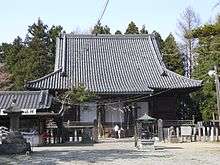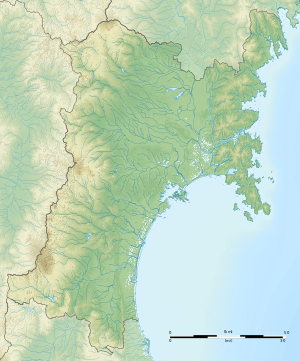Mutsu Kokubun-ji
| Mutsu Kokubun-ji | |
|---|---|
| 陸奥国分寺 | |
 Mutsu Kokubun-ji Yakushido | |
 Shown within Miyagi Prefecture  Mutsu Kokubun-ji (Japan) | |
| Basic information | |
| Location | 2-8-28 Kinoshita, Wakabayashi-ku, Sendai-shi, Miyagi-ken |
| Geographic coordinates | 38°15′02″N 140°54′02″E / 38.25056°N 140.90056°ECoordinates: 38°15′02″N 140°54′02″E / 38.25056°N 140.90056°E |
| Affiliation | Buddhist |
| Deity | Yakushi Nyorai |
| Rite | Shingon-shū Chizan-ha |
| Country | Japan |
| Status | active |
| Website | Official website (in Japanese) |
| Architectural description | |
| Founder | Emperor Shōmu |
| Completed | 741 |
Mutsu Kokubun-ji (陸奥国分寺) is a Buddhist temple in Wakabayashi-ku, Sendai, Japan, belonging to the Shingon-shū Chizan-ha sect, and is the provincial temple ("kokubunji") of former Mutsu Province. The grounds of the temple are a National Historic Site.[1] and one of its structures, the early Edo period Yakushi-dō (薬師堂) is an Important Cultural Property.[2]
History
The Shoku Nihongi records that in 741, as the country recovered from a smallpox epidemic, Emperor Shōmu ordered that a monastery and nunnery be established in every province, the kokubunji (国分寺).[3][4]
In the late Nara period, after the establishment of a centralized government under the Ritsuryō system, the Yamato court sent a number of military expeditions to what is now the Tōhoku region of northern Japan to bring the local Emishi tribes under its control.[5] After the establishment of Taga Castle, Yamato forces gradually pushed into the hinterland of what is now Miyagi Prefecture, establishing several fortified settlements along with several large-scale Buddhist temples. The Mutsu Kokubun-ji was located 9.5 kilometers from Taga Castle. The original design of the temple was a walled square area, 240 meters on a side, containing a large South Gate, Middle Gate, Kondo, Lecture Hall, Cloisters, Rectory and a seven-story Pagoda, sutra repository, bell tower, refectory, and dormitory. Excavations have revealed that this was one of the largest of the provincial temples.[4]
The temple was re-built in the Heian period after the 869 Sanriku earthquake; however, the pagoda was against destroyed in 934 AD, by lightning. The temple was again destroyed in 1189, during the campaign of Minamoto no Yoritomo against the Northern Fujiwara. Its subsequent history in the Kamakura period and Muromachi period is somewhat uncertain, although a smaller temple continued to exist on the site.
Following the establishment of Sendai Domain under the Tokugawa shogunate, Masamune Date rebuilt the complex from 1605 on a large scale, but not upon the original foundations. The Yakushi-do was completed in 1607.[6][7][8] In 1903 this structure was designated an Important Cultural Property.
The grounds of the temple were extensively excavated from 1955-1959.
See also
References
- ↑ "陸奥国分寺跡 むつこくぶんじあと". Cultural Heritage Online (in Japanese). Agency for Cultural Affairs. Retrieved 25 December 2016.
- ↑ "Database of Registered National Cultural Properties". Agency for Cultural Affairs. Retrieved 16 March 2011.
- ↑ Brown, Delmer M. (1993). Cambridge History of Japan vol. I. Cambridge University Press. p. 255.
- 1 2 Yiengpruksawan, Mimi Hall (1998). Hiraizumi: Buddhist Art and Regional Politics in Twelfth-Century Japan. Harvard University Press. pp. 22f.
- ↑ Shively, Donald H.; McCullough, William H. (1999). Cambridge History of Japan vol. II (p.31f.). Cambridge University Press.
- ↑ "Mutsu Kokubunji Temple - Yakushidō Hall". Tokyo Chizu Publishing. Archived from the original on 3 August 2012. Retrieved 16 March 2011.
- ↑ "Mutsu Kokubunji Yakushidō (in Japanese)". MiyaginoTabi. Retrieved 16 March 2011.
- ↑ "Mutsu Kokubunji Yakushidō (in Japanese)". Miyagi Prefecture. Archived from the original on 7 September 2012. Retrieved 16 March 2011.
External links
| Wikimedia Commons has media related to Mutsu Kokubun-ji. |
- Official website (in Japanese)
- Miyagi Prefecture Government site